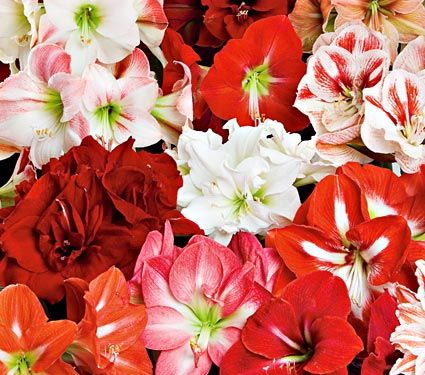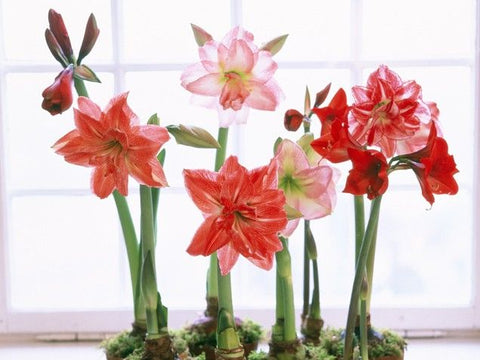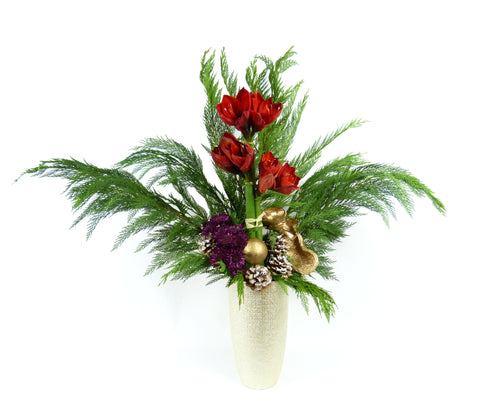Choose your frequency and needs and we will take the rest - home, office or as a gift!

The Amaryllis or as it’s botanically known Hippeastrum is one of our favorite flowers to work with. It’s perfect for holiday arrangements and has become increasingly popular for holiday gift plants, undoubtedly because the bulbs bloom very freely indoors. The large, showy flowers make a bold statement and are available in an increasing variety of colors, shapes, and sizes that fit almost any taste. We’ve created this handy guide so you too can become an Amaryllis expert!
Mythology In Greek mythology, Amaryllis was a shepherdess who loved Alteo, a shepherd with Hercules' strength and Apollo's beauty. However, Alteo only loved flowers. He'd often said that he would only love a girl who bought him a new flower. So, Amaryllis dressed in maiden's white and appeared at Alteo's door for 30 nights, each time piercing her heart with a golden arrow. When Alteo finally opened his door, he found a crimson flower, sprung from the blood of Amaryllis's heart. The word "amaryllis" comes from the Greek word "amaryssein," which means "to sparkle," referring to the bloom. Today, the amaryllis symbolizes pride, determination and radiant beauty--the kind that emanates from an inner source and flowers outward.
Features Amaryllis has tall, thick stems and large, colorful flowers. Bloom colors includes red, pink, white, cream, orange and striped and variegated shades of several other colors.
Background The amaryllis is native to South Africa, the Americas and parts of the Caribbean. It was discovered in Chile in 1828 by Eduard Frederich Poeppig, a physician and plant hunter from Leipzig, Germany.
Amaryllis Care
Planted Amaryllis-When its brilliant holiday blooms have faded, should you toss that big brown amaryllis bulb into the compost pile? No! Amaryllis, are as easy to care for as any house plant. When they're not blooming, the strap-like leaves make an attractive, architectural backdrop for other plants. With a little fertilizer and summer sun, your amaryllis will bloom again, bigger and better than ever! Treat your amaryllis as you would any houseplant, with regular water and fertilizer. Amaryllis plants like sun, the brighter the better, especially in winter. If you tuck it in a dim corner, it may survive, but more sun means better growth and better bloom next year.

Here's an easy step-by-step plan to get your amaryllis to bloom again:
1. Keep it cool through the holidays.
Enjoy your amaryllis for the maximum time possible by placing it in a location with diffuse light and cool indoor temperatures in the 60°F range. Keep it barely moist. When you water, be careful not to get the portion of the bulb that sticks above the soil wet. If you have a large bulb, you may get two or three flowering stalks that bloom over a period of several weeks.
2. Cut the flower stalks.
When the last flower has faded on each of the flower stalks, cut the flower stalk near the top of the bulb. Be careful not to injure the leaves or any emerging flower stalks. Don't be alarmed if a large amount of sap runs out of the hollow flower stalk when you cut it. This is normal if the plant has been well watered.
3. Increase light, water, and fertilizer.
It's now late winter, and your amaryllis is now in its growth phase. Your main objective is to encourage leaf production that will help the bulb bulk up for next year's flowers. It's hard to give your amaryllis too much sunlight at this time of the year. Move it to the sunniest location that you can manage. A sunroom or greenhouse space is best, but a south-facing window will work until spring comes. Fertilize it monthly with a liquid fertilizer, and never allow the soil to dry out completely.
4. Move it outdoors in spring.
As soon as the weather settles and all threat of frost is gone, move your amaryllis outdoors. Don't be alarmed if many of the leaves wither and die in the adjustment period. Wind and exposure to more sunlight may cause some of the older leaves to die; new ones will grow. Choose a sunny area where you can water the plants daily. A deck or patio works fine, and the glossy strap-shaped leaves are a good textural foil for many other plants. Fertilize the plants every two weeks with a liquid fertilizer or apply a slow release fertilizer.
5. Decide when you'd like your amaryllis to bloom.
If you want flowers for the holidays, you'll need to begin its dormant period by mid August. Withhold water, and move the pots to a location where they can be kept around 55°F. Most people don't have a space that they can keep this cool at the height of summer, so you might have to let the seasons determine bloom time for you. You can leave your amaryllis outdoors well into autumn. If you do, stop fertilizing it in late September and bring it indoors before the end of October or earlier if a heavy frost is forecast. You can bring it indoors in the pot or remove the bulb from the pot and wash the soil off the roots if you like at this time.
6. Keep it in cool storage until the bulbs signal they are ready to go.
Amaryllis usually lose all or most of their leaves during their dormant period, although it is not necessary for all the leaves to wither for the bulb to reach complete dormancy. Keep the bulb on the dry side. Check the bulb every week; after eight to ten weeks of cool storage, you should notice the tip of the new flower stalk emerging from the bulb. If you shift the bulb to a warm spot (70-80°F) for three weeks, you will encourage leaves to emerge at the same time the flower stalk is developing, but a warm treatment is not needed for floral development. You can repot the bulb in fresh soil at this point. Be careful not to bury the bulb too deeply. At least one third of the bulb should be visible above the soil surface. Don't plant the bulb in a pot that is any more than two times the diameter of the bulb. When you repot it, you may notice smaller side bulbs that can be broken away from the main bulb. These can also be potted and grown on in a sunny spot. They will not bloom this year, but may bloom after two or three years of growth.
7. Start it warm and water tentatively.
Water your amaryllis thoroughly right after you repot it, and allow the soil surface to dry a bit before watering it again. Place it in a warm spot to stimulate root growth. A sunny spot is best. If you try to re-bloom your amaryllis in dim light conditions, the flower stalk will grow long and your amaryllis will be more prone to breakage or tipping. Wait until the first flower has opened to move the plant to a location with subdued light and cool temperatures to preserve the flower as long as possible.
8. Repeat.
You can keep your amaryllis indefinitely, and if you can provide the right conditions for growth and dormancy, your bulb will get larger and multiply itself over the years. Large bulbs may produce as many as three flower stalks and some bulbs may bloom during the summer as well as during the winter, depending on temperature and other growing conditions.
Call us for a Holiday arrangement for your office or home or next holiday party!

